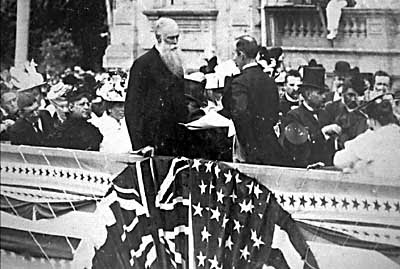By Poka Laenui
With Bible on hand, pistols in their pockets and troops at the ready, men gathered on the steps of `Iolani Palace on July 4th, 1894. Invoking the name of American liberty, they dismantled the liberty of the people of the Hawaiian nation.
Two separate camps divided Hawai`i's political environment. One, a small minority, held the power of government through the landing of the US military. The second, Hawaiian loyalists, supported their Hawaiian Queen Lili`uokalani.
The first camp wanted annexation of Hawai`i to the US, part of a larger plan to open their sugar to US markets. They sided with American expansionists like John Stevens, US Minister to Hawai`i.
The Hawaiian citizens, according to US special investigator James Blount, were almost to the man, in opposition to annexation.
US troops landed on January 16, 1893, and supported a self-proclaimed “provisional government” the next day.
A hurriedly drafted annexation treaty was sent to the US Senate in February for ratification under Harrison’s administration.
But Grover Cleveland, inaugurated President in March, sent Blount to investigate this Hawaiian affair. Given Blount’s report, Cleveland railed against US conspiracy and withdrew the treaty in December.
Sanford Dole, President of the "provisional" government, was criticized for the PG’s lack of legitimacy. He assembled a convention of 37 delegates, 19 appointed by him, the remainder elected by those who disavowed loyalty to Lili`uokalani and swore allegiance to the provisional government.
Using as their backdrop, the US Independence day celebration, Dole’s group assembled at `Iolani Palace at 8:00 AM, July 4, 1894.
With guns tucked out of public sight, William O. Smith, one of the early conspirators of the group acted as master of ceremony.
Dispensing with the opening prayer, apparently skittish over the proceedings taking place, Smith introduced Dole. Dole, looking down upon their members, proclaimed “the Republic of Hawai`i as the sovereign authority over and throughout the Hawaiian Islands.”
He went on, “And I declare the Constitution framed and adopted by the Constitutional Convention of 1894 to be the constitution and the supreme law of the Republic of Hawai`i, and by virtue of this constitution I now assume the office and authority of president thereof.”
The constitution declared all Lili`uokalani’s government’s lands, waters and citizens as those of the Republic.
While framing their activities around the American principle that the right of governance can be only achieved thru the consent of the governed, the Republic of Hawai`i was declared in just the opposite manner.
No ratification or any consent was given the Republic by Hawaiians.
Hawaiian nationals never consented to any change.
4th (2)

By Poka Laenui
With Bible on hand, pistols in their pockets and troops at the ready, men gathered on the steps of `Iolani Palace on July 4th, 1894. Invoking the name of American liberty, they dismantled the liberty of the people of the Hawaiian nation.
Two separate camps divided Hawai`i's political environment. One, a small minority, held the power of government through the landing of the US military. The second, Hawaiian loyalists, supported their Hawaiian Queen Lili`uokalani.
The first camp wanted annexation of Hawai`i to the US, part of a larger plan to open their sugar to US markets. They sided with American expansionists like John Stevens, US Minister to Hawai`i.
The Hawaiian citizens, according to US special investigator James Blount, were almost to the man, in opposition to annexation.
US troops landed on January 16, 1893, and supported a self-proclaimed “provisional government” the next day.
A hurriedly drafted annexation treaty was sent to the US Senate in February for ratification under Harrison’s administration.
But Grover Cleveland, inaugurated President in March, sent Blount to investigate this Hawaiian affair. Given Blount’s report, Cleveland railed against US conspiracy and withdrew the treaty in December.
Sanford Dole, President of the "provisional" government, was criticized for the PG’s lack of legitimacy. He assembled a convention of 37 delegates, 19 appointed by him, the remainder elected by those who disavowed loyalty to Lili`uokalani and swore allegiance to the provisional government.
Using as their backdrop, the US Independence day celebration, Dole’s group assembled at `Iolani Palace at 8:00 AM, July 4, 1894.
With guns tucked out of public sight, William O. Smith, one of the early conspirators of the group acted as master of ceremony.
Dispensing with the opening prayer, apparently skittish over the proceedings taking place, Smith introduced Dole. Dole, looking down upon their members, proclaimed “the Republic of Hawai`i as the sovereign authority over and throughout the Hawaiian Islands.”
He went on, “And I declare the Constitution framed and adopted by the Constitutional Convention of 1894 to be the constitution and the supreme law of the Republic of Hawai`i, and by virtue of this constitution I now assume the office and authority of president thereof.”
The constitution declared all Lili`uokalani’s government’s lands, waters and citizens as those of the Republic.
While framing their activities around the American principle that the right of governance can be only achieved thru the consent of the governed, the Republic of Hawai`i was declared in just the opposite manner.
No ratification or any consent was given the Republic by Hawaiians.
Hawaiian nationals never consented to any change.
A reading will take place tomorrow at 5 PM at `Iolani Palace and discussion of the events leading up to the proclaiming into existence of the Republic of Hawai`i on July 4, 1894. This event is free and open to the public.

